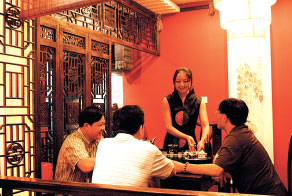Teahouses have long been where Chinese literati gather for lofty discussions of historical texts. A new teahouse has just been established to help revive that tradition. Haohuaxing Teahouse (浩华兴茶艺社), opened last week on Donghuamen Dajie near the eastern gate of Forbidden City, is a two-floor, medium-sized teahouse decorated in traditional Chinese style. From the typically Chinese window frames and screens, stone blocks at the door, to the characteristic, comfortable furniture, everything is made in line with the Chinese classic style. Fittingly, it is located just 200m from the Imperial Palace.
But what really makes this teahouse different is the precious artwork on display, on its walls and on the second floor. Beijing has plenty of good classical Chinese-style teahouses where you can get a decent sip of tea in a calm environment. This teahouse is one of the few, which offers a genuine display of ancient Chinese relics.
On the walls of the four private rooms on the ground floor, and a small pavilion style room at the corner, as well as the entire second floor, are the genuine painting and calligraphy works of some of the best Chinese ancient and contemporary artists. The themes of the artworks are diverse, but most are on landscape or scenery. There are also Qing and Ming dynasties (1368-1911) furniture on the second floor.
These displayed paintings and calligraphy works are also for sale, ranging from several thousand to several hundred thousand yuan. The artworks come with a license proving their authenticity. But it should be noted that artworks created earlier than 1911 cannot be taken out of China.
The second floor also has a small display of the owner's personal collection, of a bronze mirror, bronze sword, and a bronze ding, an ancient Chinese cooking vessel.
Green tea sells 28-88 yuan a cup (杯), or 68-980 yuan a pot (壶). Or you can order by the helping, which is three sachets of tea, each weighing 7-8g. There are almost all the famous teas in China, including dragon well (龙井), Biluochun (碧螺春), oolong (乌龙), Pu'er (普洱), black tea (红茶), green tea (绿茶), and white tea (白茶), as well as nutritional tea (保健茶). Tea performance is free of charge.
Although the tea menu is only in Chinese, the waiters are college graduates, so you can expect them to at least speak basic English. If you happen to be around Wangfujing or Forbidden City, and would like to savor tea, and appreciate Chinese paintings, Haohuaxing could be a good option.
Text by Ye Jun and photo by Guo Yingguang
9am-2pm. 63 Donghuamennei Dajie, Dongcheng District. 200 meters east of the eastern gate of Forbidden City, to the north of the street. 6522-2039. 东城区东华门内大街63号, 故宫东门东200米路北
(China Daily August 10, 2007)


